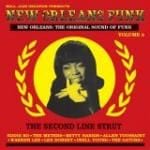
The eternal debate over America’s greatest soul/R&B record label of the 20th century is as bi-partisan as the country’s political system. The Motown vs. Stax argument, which draws a literal and symbolic line between northern and southern methodologies, is a good starting point for hashing out personal tastes, but it can ignore the fact that excellent soul music was being made in cities other than Detroit and Memphis. Of course, there were other labels in other American cities representing other pockets of rhythm and groove, most of which never had the promotional means to transcend their communities, and many of which are finally being revisited via the compilations of independent reissue labels like the Numero Group.
The city of New Orleans is one of those cities; its rich traditions of jazz (Louis Armstrong) and rock ‘n’ roll (Little Richard, Fats Domino) have a tendency to eclipse its funky and fertile soul and R&B scene. It couldn’t boast the sort of fabricated identity that put Stax and Motown on the national map (its myriad independent labels, like Minit, Sansu, Parlo, Josie, and Scram, had no consistent major-label distributor), but it did fashion a singular sound out of the multifaceted institutions of N’awlins music. Two of the major architects of the New Orleans soul/R&B sound, Allen Toussaint and the Meters, are responsible for some of the funkiest and most rewarding American music of the 1960s and ’70s. Toussaint, the city’s premier producer and songwriter in the ’60s and ’70s, worked with New Orleans icons like Ernie K-Doe, Irma Thomas, and Lee Dorsey (he wrote Dorsey’s Top 10 hit “Working in the Coal Mine”, among many others), and later, the Meters became his go-to house band. The Meters, like Motown’s Funk Brothers and Stax’s Booker T. & the MG’s, were the unsung heroes of many of Toussaint’s sessions, providing funky and sinewy accompaniment for a countless number of songs.
Both Toussaint and the Meters are all over New Orleans Funk, Volume 2, a new compilation of rare-ish New Orleans soul, R&B, and funk sides, and a sequel to Soul Jazz’s 2000 collection of the same name. New Orleans Funk, Volume 2, which spans 1962-1973 (one lone track, Art Neville’s cover of Ellis McDaniels’ “Bo Diddley” [RIP] dates from 1956), is somewhat erroneously named; while some songs on the compilation would fall easily into the “funk” category, many are more traditionally soul and R&B with an especially funky touch. The most explicitly “funk” songs are those that mimic the hard-working grooves of James Brown, like Eddie Bo’s “If It’s Good to You (It’s Good for You)” (1969) and Warren Lee’s “Mama Said We Can’t Get Married” (1968), a decidedly un-J.B. narrative of mama’s boy funk that lobbies for graduating from school before tying the knot. Cyril Neville’s “Gossip” (1970), a Meters track in everything but name, is a heavy slab of asphalt funk with sitar-esque electric guitar and the demand (met with ease, natch) to “play it real funky”. The Meters’ own “Chicken Strut” (1970), meanwhile, is stone-cold crazy funk (check the wild poultry impressions) that rocks the band’s typically bare-bones, deep-groove aesthetic — a signature that surfaces again and again on tracks like Ray J’s laidback 1973 cover of the Dr. John hit “Right Place, Wrong Time”.
On the soul and R&B side of things, New Orleans Funk, Volume 2 sports some real winners. Betty Harris has a pair of great tunes here, “Twelve Red Roses” (1967) and “Show It” (1968), both featuring the effervescent horn- and strings-specked production of Toussaint. Bonnie & Sheila’s “You Keep Me Hanging On” (not the Supremes song) was cut during the same session in 1970 that yielded Jean Knight’s “Mr. Big Stuff”, and its tough groove and smooth melody bear more than a passing resemblance. (More correlations to “Mr. Big Stuff” appear later in the compilation with Jimmy Hicks’ “I’m Mr. Big Stuff” [1972], an answer song that replicates its subject’s rhythm, melody, stiff guitar, and background singers.) Prospective dance crazes are here, too (Danny White’s “The Twitch”, from 1963, is both funny and floor-worthy), as are pop-soul crossovers like Inell Young’s incredibly aerodynamic “What Do You See in Her” (1973) and Johnny Moore’s “Haven’t I Been Good to You”, whose melody nods to the Temptations’ “(I Know) I’m Losing You”.
For all intents and purposes, New Orleans Funk, Volume 2 is a Toussaint compilation: it features many of his original compositions (one of his most covered, “Fortune Teller”, written under the pseudonym Naomi Neville, is performed here by Benny Spellman) and interpretations (his cover of “Tequila”, from 1969, imagines the song as a Cuban-New Orleans amalgam), and even those songs that don’t feature Toussaint in some way are arguably indebted to his writing and production styles. Compilations such as these whet appetites for a much larger, boxed-set overview of Toussaint’s productions from the ’60s and ’70s. Because as good as New Orleans Funk, Volume 2 is, it merely scratches the surface.
